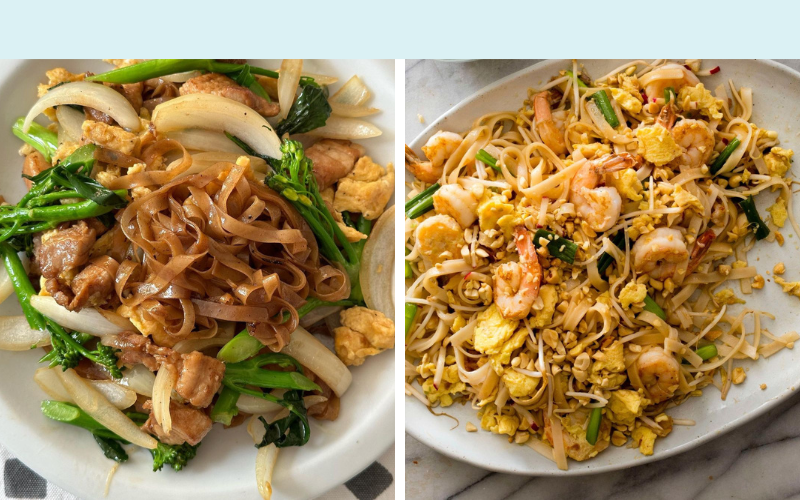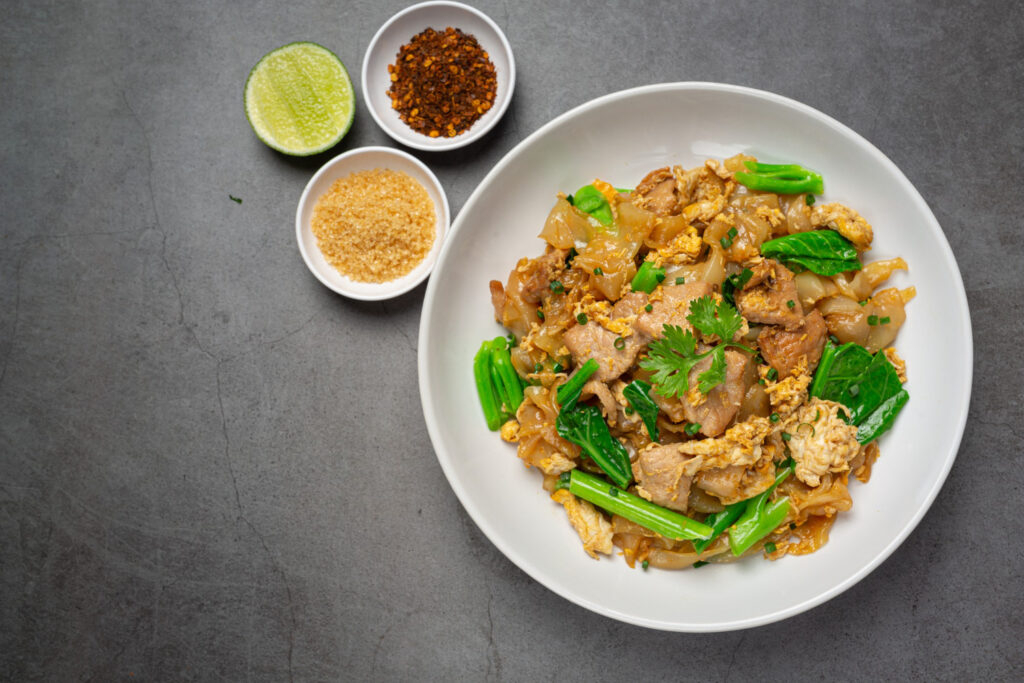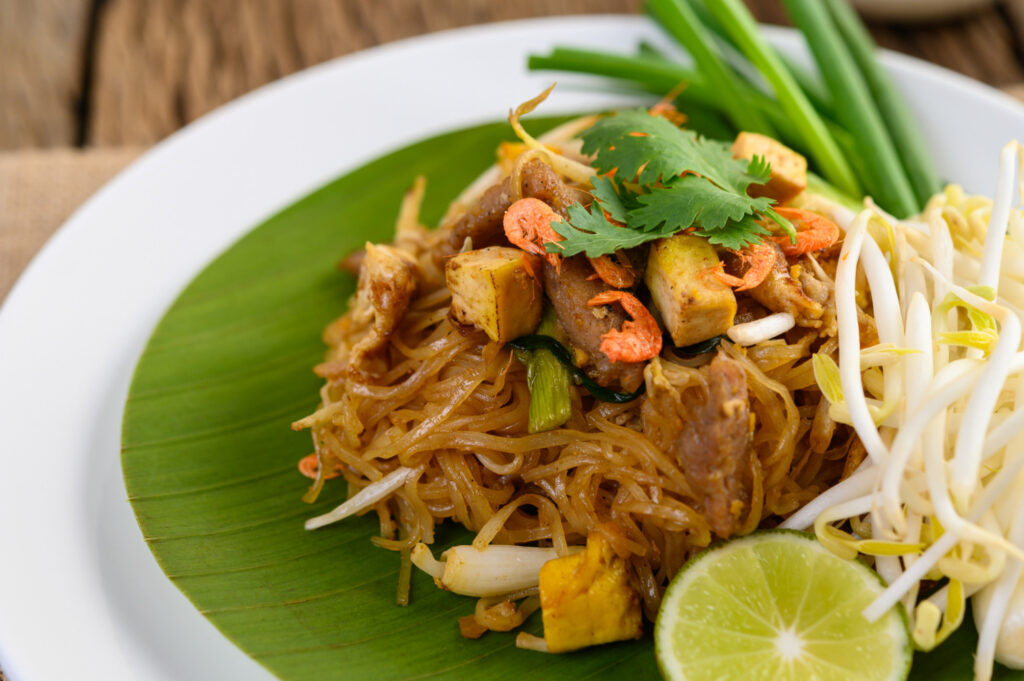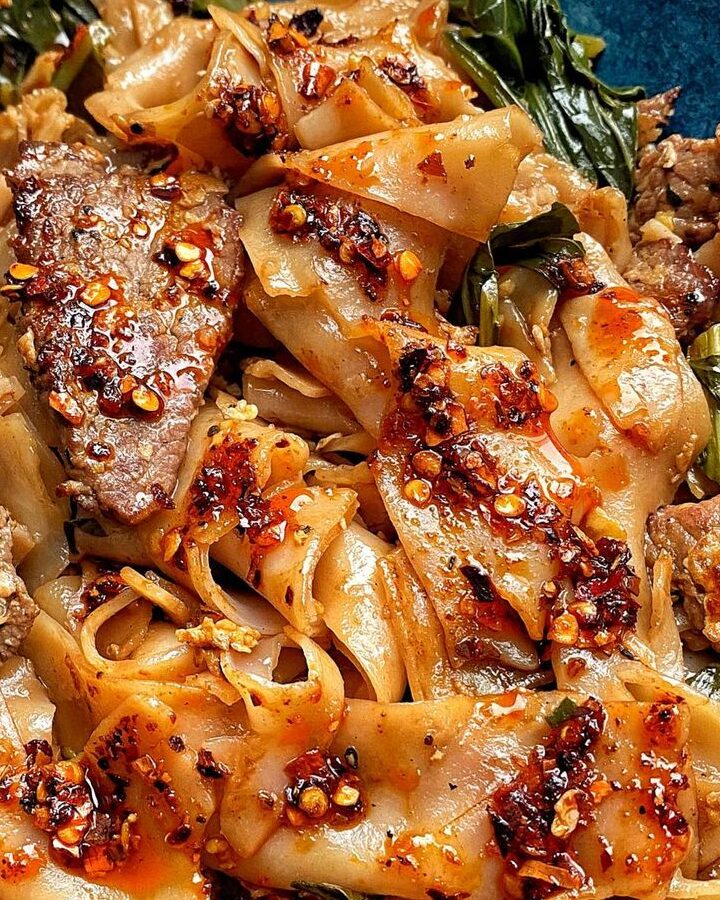Thai cuisine has captured the hearts and taste buds of food enthusiasts worldwide. This article delves into the ultimate showdown between two beloved Thai noodle dishes: Pad See Ew vs Pad Thai. Join us as we explore their origins, ingredients, flavors, and cultural significance, unraveling the battle between these iconic culinary creations.
Discover the nuances that make each dish unique and gain insights into why they have gained such popularity both in Thailand and beyond. Get ready to embark on a mouthwatering journey through the world of Pad See Ew and Pad Thai.
Read more: Pad See Ew vs Drunken Noodles: A Thai Noodle Showdown
What does Pad See Ew and Pad Thai?

Pad See Ew is a Thai stir-fried noodle dish that typically features wide, flat rice noodles. It has its origins in Thailand and is commonly found in Thai street food stalls and restaurants.
The traditional preparation involves stir-frying the noodles with a combination of protein (such as beef, chicken, or pork), Chinese broccoli, soy sauce, and other seasonings. The dish has a rich and savory flavor profile, with a slightly sweet and salty taste.
On the other hand, Pad Thai is another popular Thai noodle dish that has gained international fame. It has a more complex history, with influences from Chinese and Ayutthaya cuisine.
Pad Thai consists of thin rice noodles stir-fried with various ingredients, including shrimp or chicken, bean sprouts, eggs, tofu, and crushed peanuts. The sauce for Pad Thai is typically made with tamarind paste, fish sauce, sugar, and chili, resulting in a harmonious blend of sweet, tangy, and slightly spicy flavors.
While both dishes are beloved in Thai cuisine, they have distinct characteristics and flavor profiles. Pad See Ew offers a heartier and more robust taste, with the dark soy-based sauce adding depth and richness to the dish. In contrast, Pad Thai has a lighter and brighter flavor, with the tamarind-based sauce providing a tangy and slightly sour note.
What are the main ingredients in Pad See Ew and Pad Thai?
Pad See Ew

In Pad See Ew, the main key ingredients typically include:
- Wide, flat rice noodles: These noodles give the dish its distinct texture and are the foundation of Pad See Ew.
- Protein (beef, chicken, or pork): The choice of protein can vary, but it is usually stir-fried along with the noodles.
- Chinese broccoli: Also known as gai lan, this leafy green vegetable is a signature ingredient in Pad See Ew. It provides a slightly bitter and earthy flavor.
- Dark soy sauce: This soy sauce is thicker and has a sweeter and less salty taste compared to regular soy sauce. It gives Pad See Ew its rich, dark color and adds depth to the dish.
- Garlic: Garlic is commonly used in Thai cooking and adds aromatic notes to stir-fried noodles.
Pad Thai

In Pad Thai, the main key ingredients typically include:
- Thin rice noodles: These noodles are the base of Pad Thai and provide a chewy texture.
- Protein (shrimp or chicken): Shrimp or chicken is commonly used, although other protein options like tofu or beef can also be included.
- Bean sprouts: Bean sprouts add a refreshing crunch to the dish and contribute to its overall texture.
- Eggs: Eggs are typically scrambled and mixed into the stir-fried noodles, adding richness and additional protein.
- Tamarind paste: Tamarind paste is a crucial ingredient in Pad Thai, providing a tangy and slightly sour flavor to the dish.
- Fish sauce: Fish sauce is a staple in Thai cuisine and adds a savory umami taste to Pad Thai.
- Sugar: A small amount of sugar is added to balance the flavors and provide a touch of sweetness.
- Crushed peanuts: Peanuts are commonly sprinkled on top of Pad Thai to add a nutty crunch and enhance the overall taste.
What is the difference between Pad Thai and Pad See Ew?
Here’s a table highlighting the main differences between Pad Thai and Pad See Ew:
| Pad Thai | Pad See Ew | |
| Noodles | Thin rice noodles | Wide, flat rice noodles |
| Sauce | Tamarind-based sauce | Dark soy-based sauce |
| Vegetables | Bean sprouts, chives | Chinese broccoli |
| Protein | Shrimp or chicken (common), tofu, beef | Beef, chicken, or pork (common) |
| Flavor | Sweet, tangy, and slightly sour | Rich, savory, and slightly sweet |
| Toppings | Crushed peanuts, lime wedges | No specific traditional toppings |
| Texture | Chewy noodles, crunchy bean sprouts | Soft noodles, tender Chinese broccoli |
Please note that variations in recipes and personal preferences can lead to some differences in specific ingredients and flavors. This table provides a general overview of the main distinctions between Pad Thai and Pad See Ew.
Nutrition facts of Pad See Ew and Pad Thai
Below is a table comparing some general nutrient facts about Pad See Ew vs Pad Thai calories
| Pad See Ew | Pad Thai | |
| Calories (per cup) | Approximately 300-400 calories | Approximately 400-500 calories |
| Protein | Varies based on protein choice (beef, chicken, pork) | Varies based on protein choice (shrimp, chicken, tofu) |
| Carbohydrates | Mainly from rice noodles and vegetables | Mainly from rice noodles and vegetables |
| Fat | Varies based on protein and oil used | Varies based on protein and oil used |
| Fiber | Moderate amount from vegetables | Moderate amount from vegetables |
| Sodium | Varies based on soy sauce or fish sauce used | Varies based on fish sauce used |
| Sugar | Generally low, but can vary with added sugars | Generally low, but can vary with added sugars |
| Vitamins and Minerals | Varies depending on ingredients used | Varies depending on ingredients used |
Must read: Is Pad Thai Healthy? Advantages and Disadvantages
Is Pad Thai or Pad See Ew healthier?

When it comes to determining which dish is healthier between Pad Thai and Pad See Ew, it depends on various factors, including the specific ingredients used, portion sizes, and individual dietary needs. However, there are a few considerations to keep in mind:
Calorie content
Both Pad Thai and Pad See Ew can vary in their calorie content. Pad Thai tends to have a slightly higher calorie count due to the use of peanuts and a potentially higher amount of oil in the cooking process.
On the other hand, Pad See Ew calories usually contain less, as it uses a dark soy-based sauce instead of the tamarind-based sauce used in Pad Thai.
Protein choices
The choice of protein in the dish can impact its overall healthiness. Opting for lean protein sources like chicken, shrimp, or tofu can make both dishes healthier.
However, it’s important to note that some variations of Pad Thai may include fried proteins or higher-fat cuts of meat, which can increase the dish’s calorie and fat content.
Vegetable content
Both dishes typically include vegetables, with Pad See Ew featuring Chinese broccoli and Pad Thai incorporating bean sprouts. Vegetables add essential nutrients and fiber to the dishes, making them healthier choices.
However, the specific vegetable content can vary, and it’s possible to customize the dish by adding more vegetables or choosing additional nutritious options.
Sodium and sugar
Thai cuisine often incorporates various sauces and seasonings that may contain sodium and sugar. While both Pad Thai and Pad See Ew contain soy sauce or fish sauce, which can be high in sodium, the overall sodium content can be managed by using reduced-sodium options or controlling the amount of sauce added.
Additionally, the sugar content in Pad Thai can be higher due to the use of tamarind paste and sweeteners, whereas Pad See Ew typically contains less added sugar.
Both Pad Thai and Pad See Ew can be enjoyed as part of a balanced diet. To make them healthier, consider choosing lean protein sources, increasing vegetable content, moderating portion sizes, and being mindful of sauces and seasonings used. It’s important to listen to your body’s needs and preferences while making choices that align with your health goals.
FAQs
Can I make Pad See Ew or Pad Thai vegetarian or vegan?
Yes, both Pad See Ew and Pad Thai can be made vegetarian or vegan. For Pad See Ew, you can substitute the protein (beef, chicken, or pork) with tofu or plant-based protein alternatives.
Ensure that the sauces used are vegetarian or vegan-friendly, as some brands may contain animal-derived ingredients. Similarly, for Pad Thai, you can replace shrimp or chicken with tofu or vegetables.
Be mindful of the sauce ingredients, such as fish sauce, which can be substituted with vegan fish sauce or soy sauce for a vegetarian or vegan version.
Are Pad See Ew and Pad Thai gluten-free?
Is Pad Thai gluten free? Is Pad See Ew gluten free? Pad See Ew and Pad Thai can be made gluten-free with certain modifications. The primary concern lies with the use of soy sauce, which often contains gluten. However, gluten-free soy sauce or tamari can be used as a substitute in the sauces.
It is important to verify the gluten-free status of other ingredients used, such as rice noodles and seasonings, to ensure they are certified gluten-free. When dining out, you can inquire with the restaurant about their gluten-free options or ask for any necessary adjustments to accommodate your dietary needs.
Can I substitute ingredients in Pad See Ew or Pad Thai?
Yes, you can substitute certain ingredients in Pad See Ew or Pad Thai based on your preferences or dietary restrictions. For example, in Pad See Ew, you can substitute the protein (beef, chicken, or pork) with alternative options like shrimp, tofu, or even vegetables.
Similarly, in Pad Thai, you can replace the protein (shrimp or chicken) with tofu, beef, or additional vegetables. You can also customize the vegetable selection or adjust the level of spiciness by adding more or less chili.
Which dish is spicier: Pad See Ew or Pad Thai?
Typically, Pad Thai is considered to be milder in terms of spiciness compared to Pad See Ew. Pad See Ew usually has a milder and less spicy flavor profile, focusing more on savory and sweet notes.
However, it’s important to note that the level of spiciness can vary depending on the individual recipe or the specific preferences of the person preparing the dish. It’s always recommended to inquire about the spiciness level when ordering or preparing these dishes, and you can request for the spiciness to be adjusted according to your preference.
Are peanuts always included in Pad Thai?
Peanuts are commonly included in Pad Thai, but their presence can vary depending on personal preferences and regional variations. Traditional Pad Thai recipes often include crushed peanuts as a topping, which adds a delightful nutty crunch to the dish.
However, some variations or adaptations of Pad Thai may omit peanuts or offer them as an optional garnish. If you have a peanut allergy or prefer to avoid peanuts, you can request to have them omitted when ordering or prepare the dish without peanuts at home.
Is Pad See Ew sweeter or saltier than Pad Thai?
Pad See Ew is generally considered to be sweeter than Pad Thai. The use of a dark soy-based sauce in Pad See Ew contributes to its slightly sweet and rich flavor profile. On the other hand, Pad Thai typically has a balance of sweet, sour, and slightly tangy flavors from the tamarind-based sauce.
While both dishes can have savory elements, Pad See Ew leans more towards sweetness while Pad Thai offers a more complex flavor profile. However, it’s worth noting that the specific sweetness or saltiness level can vary depending on the individual recipe or the preferences of the cook.
Can I find Pad See Ew and Pad Thai in Thai restaurants outside of Thailand?
Yes, Pad See Ew and Pad Thai are popular Thai dishes enjoyed worldwide. Thai cuisine has gained significant international popularity, and many Thai restaurants outside of Thailand offer these dishes on their menus.
Whether you’re in North America, Europe, Asia, or any other region, it is highly likely that you will find Pad See Ew and Pad Thai in Thai restaurants or even some Asian food establishments.
What is the best way to reheat leftover Pad See Ew or Pad Thai?
The best way to reheat leftover Pad See Ew or Pad Thai is by using a stovetop or microwave. Here’s how:
- Stovetop: Heat a non-stick pan or wok over medium heat. Add a small amount of oil and stir-fry the leftover noodles and ingredients until heated through. Add a splash of water or sauce if needed to prevent drying out.
- Microwave: Transfer the leftover Pad See Ew or Pad Thai to a microwave-safe container. Cover loosely with a microwave-safe lid or microwave-safe wrap. Heat in the microwave in 30-second intervals, stirring in between, until heated thoroughly. Adjust the heating time based on the quantity and wattage of your microwave.
It’s important to note that reheating may slightly alter the texture of the noodles, but this method helps to retain the flavors. To ensure food safety, make sure to refrigerate any leftovers promptly and consume them within a few days.
Are Pad See Ew and Pad Thai suitable for people with diabetes?
As with any dish, it is important for individuals with diabetes to consider the ingredients and portion sizes when consuming Pad See Ew or Pad Thai. Both dishes contain carbohydrates from the rice noodles and sauces, which can impact blood sugar levels. However, there are a few considerations:
- Portion Control: Controlling the portion size is crucial to managing blood sugar levels. Opt for smaller servings and pair the dish with protein and non-starchy vegetables to help balance the meal.
- Carbohydrate Management: If you have diabetes, it’s important to be mindful of the carbohydrate content in the dish. You can consult with a dietitian or use nutrition information to help you manage your carbohydrate intake while enjoying Pad See Ew or Pad Thai.
It’s always advisable for individuals with diabetes to consult with a healthcare professional or a registered dietitian for personalized guidance on managing their dietary choices and portion sizes.
Are Pad See Ew and Pad Thai typically served as a main course or side dish?
Both Pad See Ew and Pad Thai are commonly served as main courses in Thai cuisine. They are complete dishes that include noodles, proteins, vegetables, and sauces, providing a balanced and satisfying meal on their own.
However, in some instances, smaller portions of Pad See Ew or Pad Thai can be served as part of a wider selection of dishes in a family-style or shared meal setting. This can vary depending on the restaurant or individual preferences.
When ordering at a restaurant, Pad See Ew and Pad Thai are typically presented as main course options on the menu. If you’re preparing them at home, they can be enjoyed as standalone main courses, and you can add side dishes or accompaniments if desired.
Conclusion
Finally, exploring the world of Pad See Ew vs Pad Thai reveals two distinct and beloved Thai noodle dishes. While both dishes share similarities, they also possess unique characteristics that set them apart.
When it comes to choosing between Pad See Ew and Pad Thai, personal preference plays a significant role. Some may favor the robust and comforting nature of Pad See Ew, while others may prefer the vibrant and tangy flavors of Pad Thai. It’s a matter of individual taste and the experience one seeks from Thai cuisine.
It’s worth noting that both dishes can be enjoyed as part of a balanced diet. By considering factors such as protein choices, vegetable content, and portion sizes, it is possible to make healthier choices while relishing the authentic flavors of these dishes.
Whether you find yourself craving the deep umami of Pad See Ew or the zesty complexity of Pad Thai, exploring these Thai noodle classics allows for an appreciation of the rich culinary heritage and cultural significance of Thailand. So, venture into your local Thai restaurant or kitchen and embark on a delectable journey, savoring the delightful nuances of Pad See Ew and Pad Thai.
Keep reading: Pad Thai vs Lo Mein – Difference, Origin, Taste and More